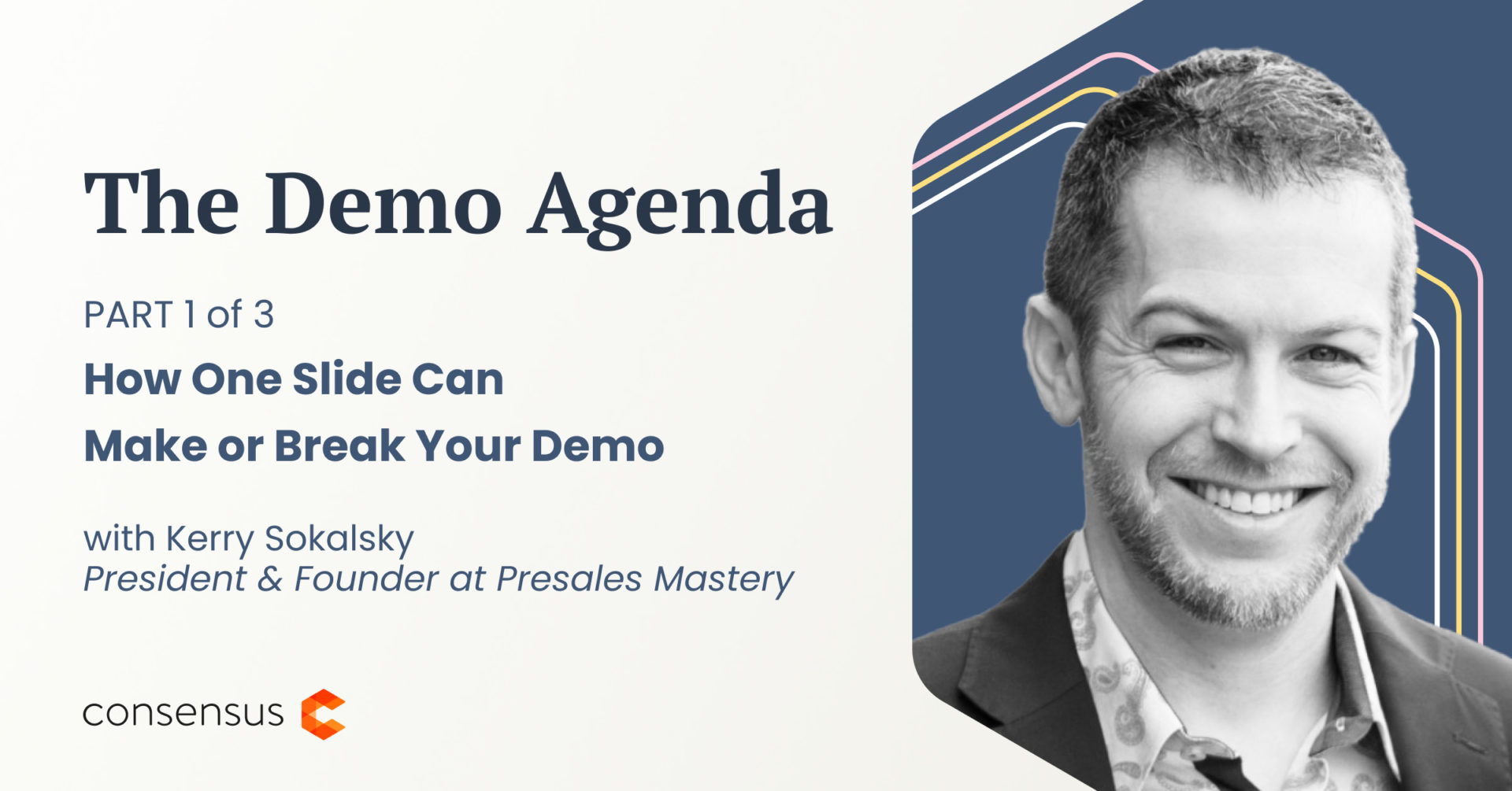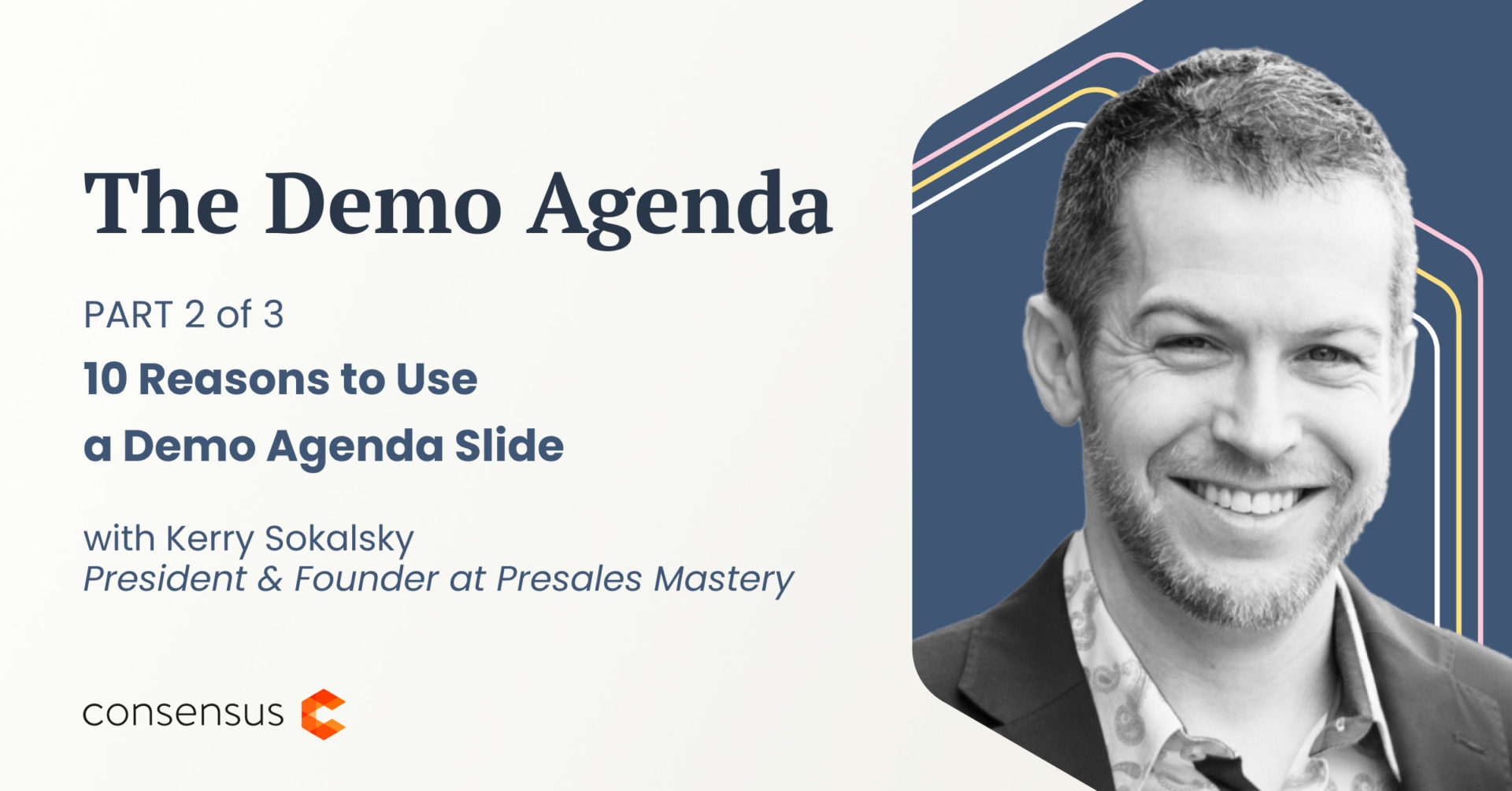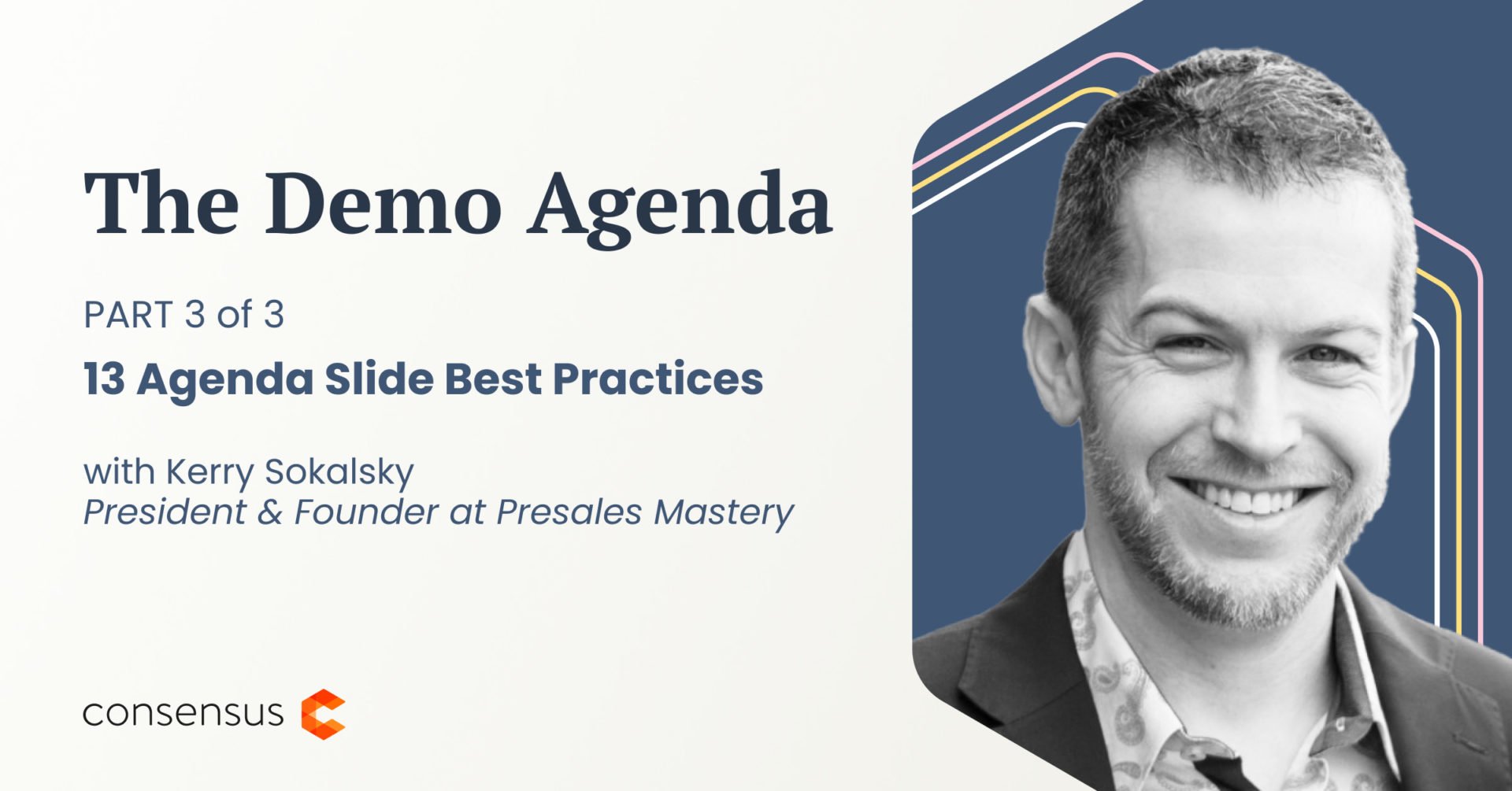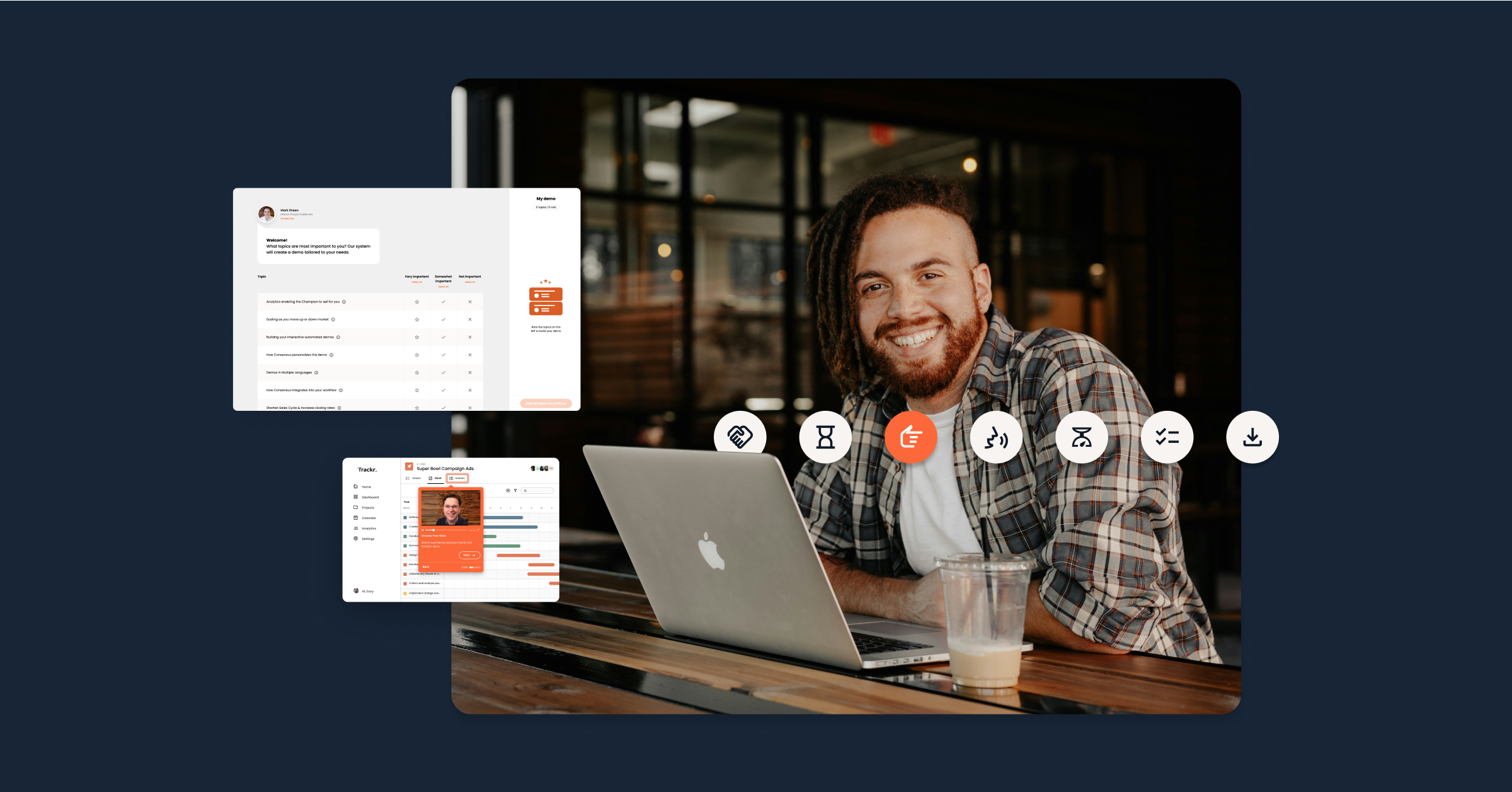Kerry Sokalsky is the Founder and President of Presales Mastery, helping B2B software sellers win ...
Close more deals with
Demo Automation.
Watch a Demo
You may be wondering how discussing a single presentation slide, the demo agenda, can possibly justify its own DEMOFEST session and blog series. Don’t worry – there’s plenty of substance here to add to your bag of tricks and immediately start improving your demos.
Before we get too far into it, I want to clarify something. When I mention the demo agenda slide, I’m not talking about the meeting agenda – the bulleted list of topics to be covered during the course of the meeting. Those are typically covered by the Sales Rep and, at best, tend to have two words to describe what’s going to happen during the demo: “Product Demonstration”.
Instead, the agenda slide I’m referring to is a separate slide that explains in detail what’s going to be covered during the demo portion of the meeting. Using a demo agenda slide is a tactical approach to organizing and communicating to your audience what will be covered, and that you can put into practice in your next demo to see positive results right away.
The Numbers Don’t Lie
At Presales Mastery, we coach technical sellers on demo performance for a living. We’re constantly providing very specific feedback on how clients can improve their demo delivery execution, based on evaluating recordings of demos delivered to prospects.
To give you some insight into our process, we score every demo against a detailed Demo Best Practices Scorecard that contains over 100 metrics. Across all the demos we’ve coached over the past 4 years, those that used a demo agenda slide scored 22% higher overall than those that didn’t.
Only about 35% of our clients used a demo agenda slide before starting a coaching engagement with us. Not using an agenda slide makes it impossible for the audience to know where the demo is going before they get there, essentially leaving them in the dark. The buyer enablement movement dictates that prospects should ideally be driving the sales, or more accurately, the buying experience, so why would they agree to spend an hour of their time if they don’t know what they’re going to see?
Seeing the Menu Before You Eat
Imagine you’ve been invited out to dinner by an acquaintance to a restaurant you know nothing about. The first thing you probably do is hop online to check out the menu or read some customer reviews. But imagine the restaurant has zero online presence – there is no menu or reviews to be found. Would you still want to go? Probably not, but for argument’s sake, let’s assume but you’re really hungry and decide to chance it.
Now imagine you get to the restaurant, and you learn there are no physical menus at all. In fact, you don’t even get to choose what you eat. The restaurant provides a set tasting menu where the chef decides every dish for you, and you don’t find out what those dishes are until they show up at the table. And did I mention the meal costs $350 per person?
For some, this may be an exciting way to experience new foods, but for most people this scenario would inspire more apprehension and potential disappointment than anticipation and enthusiasm. Having no say or forewarning about what you’re going to experience can be an uncomfortable experience.
That’s what a demo without an agenda slide is like for your prospects. Yes, they’ll probably assume you’ll cover the highlights of whatever products you offer, but they don’t know if they’re going to learn about what’s really important to them or if anything you plan to cover is even applicable. They’re worried they’ll waste an hour being bored to death with irrelevant features and topics that they don’t care about.
The Value of a Written Agenda
If customers are concerned with boredom, why would we insist on adding yet another slide to present? Why doesn’t simply telling the audience the agenda work just as well? Here are three reasons why using a slide is often a better approach.
- Visuals are more memorable. Your audience will retain what they see on a visual agenda more effectively than if they just hear it. There’s a Chinese proverb that says, “I hear it, I forget. I see it, I remember.” And science backs this up. Studies show that auditory or hearing memory is reliable for immediate recall, but visual memory is much more effective for retrieving information stored in our long term memory. In our brains, visual memory has a direct path to storage while auditory memory has to make various synaptic pit stops to reach its destination before the memory can be stored. This means the recall and recognition from hearing information tends to be weaker than when you see the same information.
- Visuals simplify validation. Having a demo agenda is important, but it’s equally important to validate the agenda with the audience for both completeness and relevance. Seeing the agenda written out on a slide makes it easier for the audience to determine if everything included is useful or if anything critical needs to be added (so we don’t lose for something we didn’t show). In most cases, we cover a lot of information in our demos. Just verbally describing the agenda to an audience makes it harder for them to determine if everything you plan to show is relevant for them.
- Visuals help you go the extra mile. We need to win every impression with our audiences. The best product doesn’t always win, and the cheapest product doesn’t always win. Deals are more often won by the vendor who provides the best buying experience. We often only get to engage with our clients late in the sales cycle, so it’s important to win every interaction with them. Having a written agenda leaves a more polished impression in the minds’ of your customers. A verbal agenda can give the perception you’re winging it, but a formal written agenda can provide the impression that you’ve prepared extensively for the presentation.
Taking It to the Next Level
An agenda slide is a simple, yet very effective way to elevate your demo game. Written agendas are a better approach than just verbally describing the agenda because they allow the audience to more easily clarify and validate what’s going to be covered. People also remember information more effectively when they read it. Detailed agendas not only inform the customer about the journey you plan to take them on, but help your demo be infinitely more successful in a slew of other ways.
Up next, we’ll provide 10 reasons you should consider adding a demo agenda slide to your presentations and 13 best practices for optimally delivering your agendas every time. If you want all the tips and tricks on demo agendas in one place, check out my DEMOFEST 2022 session here.





